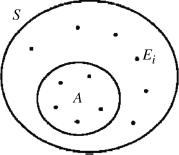4.2 Events within the Sample Space
Let us define a random experiment as a class of occurrences that can happen repeatedly, for an unlimited number of times, under essentially unchanged conditions. That is, we should be able to perform “similar trials” of this experiment “in the long run.” A random phenomenon is a phenomenon such that, on any given trial of a random experiment, the outcome is unpredictable. The resulting outcome will be termed an event, that is, an event is an outcome of a random experiment.
The sample space (denoted by S) is the collection of all possible outcomes of a random experiment; it is a class of events that are mutually exclusive and collectively exhaustive. A simple event ![]() is a possible outcome of a random experiment that cannot be decomposed into a combination of other events—it is essentially a point in S (Fig. 4.2). A compound event A is an event that can be decomposed into simple events (Fig. 4.2). (Here A is made up of five simple events.)
is a possible outcome of a random experiment that cannot be decomposed into a combination of other events—it is essentially a point in S (Fig. 4.2). A compound event A is an event that can be decomposed into simple events (Fig. 4.2). (Here A is made up of five simple events.)
Figure 4.2 Events as subsets of ![]() .
.

Thus far, we have been dealing exclusively with points (or groups of points) in S. How do we get some numbers out of our random experiment? This is the job of the random variable X ...
Get Statistical Inference: A Short Course now with the O’Reilly learning platform.
O’Reilly members experience books, live events, courses curated by job role, and more from O’Reilly and nearly 200 top publishers.

